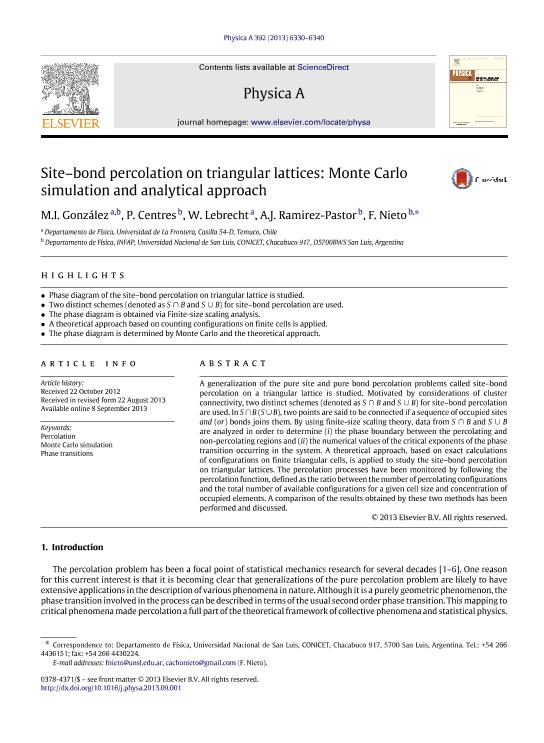Mostrar el registro sencillo del ítem
dc.contributor.author
Gonzalez Flores, Mariela Isabel
dc.contributor.author
Centres, Paulo Marcelo

dc.contributor.author
Lebrecht, W.
dc.contributor.author
Ramirez Pastor, Antonio Jose

dc.contributor.author
Nieto Quintas, Felix Daniel

dc.date.available
2016-05-13T21:42:02Z
dc.date.issued
2013-12
dc.identifier.citation
Gonzalez Flores, Mariela Isabel; Centres, Paulo Marcelo; Lebrecht, W.; Ramirez Pastor, Antonio Jose; Nieto Quintas, Felix Daniel; Site-bond percolation on triangular lattices: Monte Carlo simulation and analytical approach; Elsevier; Physica A: Statistical Mechanics and its Applications; 392; 24; 12-2013; 6330-6340
dc.identifier.issn
0378-4371
dc.identifier.uri
http://hdl.handle.net/11336/5676
dc.description.abstract
A generalization of the pure site and pure bond percolation problems called site–bond percolation on a triangular lattice is studied. Motivated by considerations of cluster connectivity, two distinct schemes (denoted as S∩B and S∪B) for site–bond percolation are used. In S∩B (S∪B), two points are said to be connected if a sequence of occupied sites and (or ) bonds joins them. By using finite-size scaling theory, data from S∩B and S∪B are analyzed in order to determine (i) the phase boundary between the percolating and non-percolating regions and (ii) the numerical values of the critical exponents of the phase transition occurring in the system. A theoretical approach, based on exact calculations of configurations on finite triangular cells, is applied to study the site–bond percolation on triangular lattices. The percolation processes have been monitored by following the percolation function, defined as the ratio between the number of percolating configurations and the total number of available configurations for a given cell size and concentration of occupied elements. A comparison of the results obtained by these two methods has been performed and discussed.
dc.format
application/pdf
dc.language.iso
eng
dc.publisher
Elsevier

dc.rights
info:eu-repo/semantics/openAccess
dc.rights.uri
https://creativecommons.org/licenses/by-nc-nd/2.5/ar/
dc.subject
Percolation
dc.subject
Phase Transition
dc.subject
Monte Carlo Simulation
dc.subject
Phase Diagrams
dc.subject.classification
Física de los Materiales Condensados

dc.subject.classification
Ciencias Físicas

dc.subject.classification
CIENCIAS NATURALES Y EXACTAS

dc.title
Site-bond percolation on triangular lattices: Monte Carlo simulation and analytical approach
dc.type
info:eu-repo/semantics/article
dc.type
info:ar-repo/semantics/artículo
dc.type
info:eu-repo/semantics/publishedVersion
dc.date.updated
2016-05-13T13:43:27Z
dc.journal.volume
392
dc.journal.number
24
dc.journal.pagination
6330-6340
dc.journal.pais
Países Bajos

dc.journal.ciudad
Amsterdam
dc.description.fil
Fil: Gonzalez Flores, Mariela Isabel. Consejo Nacional de Investigaciones Científicas y Técnicas. Centro Científico Tecnológico San Luis. Instituto de Física Aplicada; Argentina. Universidad de La Frontera. Departamento de Física; Chile
dc.description.fil
Fil: Centres, Paulo Marcelo. Consejo Nacional de Investigaciones Científicas y Técnicas. Centro Científico Tecnológico San Luis. Instituto de Física Aplicada; Argentina
dc.description.fil
Fil: Lebrecht, W.. Universidad de La Frontera. Departamento de Física; Chile
dc.description.fil
Fil: Ramirez Pastor, Antonio Jose. Consejo Nacional de Investigaciones Científicas y Técnicas. Centro Científico Tecnológico San Luis. Instituto de Física Aplicada; Argentina
dc.description.fil
Fil: Nieto Quintas, Felix Daniel. Consejo Nacional de Investigaciones Científicas y Técnicas. Centro Científico Tecnológico San Luis. Instituto de Física Aplicada; Argentina
dc.journal.title
Physica A: Statistical Mechanics and its Applications

dc.relation.alternativeid
info:eu-repo/semantics/altIdentifier/url/http://www.sciencedirect.com/science/article/pii/S0378437113008303
dc.relation.alternativeid
info:eu-repo/semantics/altIdentifier/doi/http://dx.doi.org/10.1016/j.physa.2013.09.001
Archivos asociados
